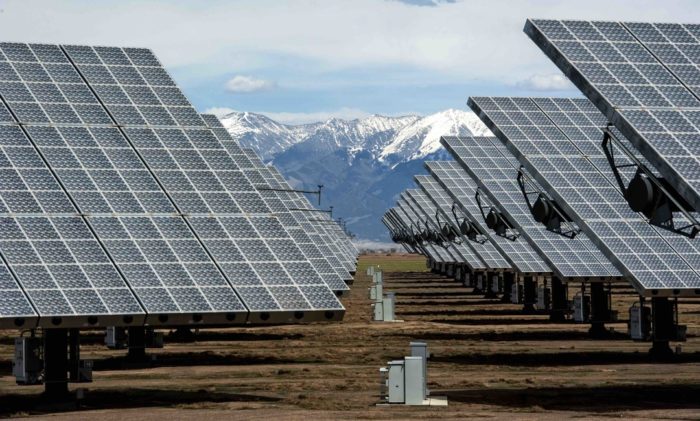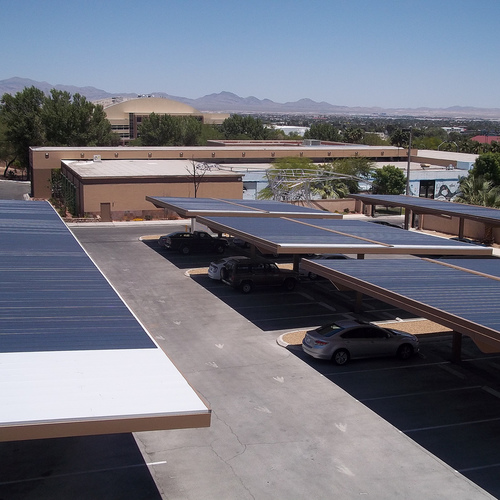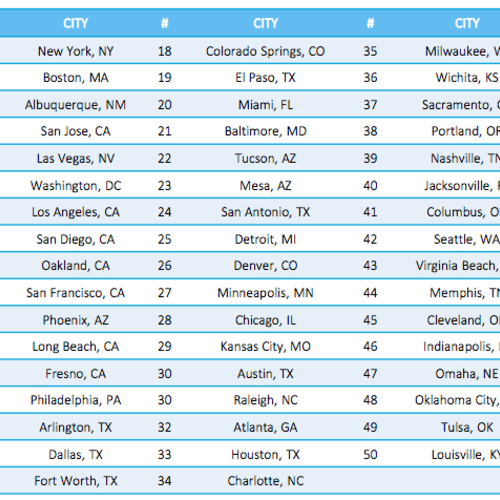
Image Credit: Dennis Schroeder/National Renewable Energy Laboratory
A study by researchers at the Massachusetts Institute of Technology finds that there is more than enough solar energy potential to meet current and future demands for energy, providing that research continues on developing more advanced solar panels and lots more money is invested in deploying them.
The authors of the report, The Future of Solar Energy, said that while continuing research and development are key to developing more advanced panels, existing crystalline silicon technology is mature, and manufacturing capacity is already in place, to dominate the market for the next couple of decades.
But tepid investments are one of several problems yet to be solved. The U.S., for example, has 5 percent of the world’s population but uses 26 percent of the world’s power, and generates less than 1 percent of its electricity from solar power.
“Massive expansion of solar generation worldwide by mid-century is likely a necessary component of any serious strategy to mitigate climate change,” the report says. “Fortunately, the solar resource dwarfs current and projected future electricity demand. In recent years, solar costs have fallen substantially and installed capacity has grown very rapidly…
“The main goal of U.S. solar policy should be to build the foundation for a massive scale-up of solar generation over the next few decades.”
Authors identified three challenges for ramping up solar generation of electricity: developing new solar technologies, integrating solar generation on a large scale into the existing grid, and rewriting government policies to support a wider adoption of photovoltaic (PV) technology.
More investment in technology
At the moment, the dominant PV technology is wafer-based crystalline silicon, the report says, which accounts for about 90 percent of installed capacity. It’s a mature technology supported by a fast-growing global industry. Yet non-module costs (called “balance of system,” or BOS, costs) account for 65 percent of utility-scale costs and 85 percent of residential systems.
“Therefore, federal R&D support should focus on fundamental research into novel technologies that hold promise for reducing both module and BOS costs,” the report says. “The federal PV R&D program should focus on new technologies, not — as has been the trend in recent years — on near-term reductions in the cost of crystalline silicon.”
Existing thin-film technologies, an alternative to silicon wafer modules, are cost-competitive with silicon, but some of them rely on raw materials that are in very short supply. For example, the abundance of tellurium, used to manufacture cadmium telluride (CdTe) films, are estimated to be only one-quarter that of gold, the authors said.
Emerging thin-film technologies have the potential to provide “superior performance with lower manufacturing complexity and module cost.” They have “the potential to significantly reduce the cost of PV-generated electricity in the future.”
The federal government should concentrate its R&D spending on developing environmentally friendly thin films made with abundant materials. Research aimed at near-term cost reductions for silicon panels should be “reversed.”
Integrating solar into the grid
Initially, the introduction of distributed PV-generated electricity lowers the cost of the distribution system. But when distributed PV becomes a significant share of overall electricity generation, the “net effect is to increase distribution costs (and thus local rates).” The reason is that local grids weren’t designed to handle lots of PV input from customers, and in order to maintain “power quality” utilities have to invest in new equipment.
“In an efficient and equitable distribution system, each customer would pay a share of distribution network costs that reflected his or her responsibility for causing those costs,” the authors said. “Instead, most U.S. utilities bundle distribution network costs, electricity costs, and other costs and then charge a uniform per-kWh rate that just covers all these costs.”
When this rate is combined with net-metering, the result “is a subsidy to residential and other distributed solar generators that is paid by other customers on the network.” This argument about “cost shifting” is at the root of many disputes around the country between solar advocates and utility managers.
“Because of these conflicts, robust, long-term growth in distributed solar generation likely will require the development of pricing systems that are widely viewed as fair and that lead to efficient network investment. Therefore, research is needed to design pricing systems that more effectively allocate network cost to the entities that cause them,” the report says.
When it comes to subsidizing the deployment of current technology, the report suggests solar output, rather than investment, would be the least expensive way of growing PV.
In the U.S., the main federal incentive are tax credits, but subsidies would be much more effective, the report adds, “if they rewarded generation, not investment.”
Still, the authors said, “now is the wrong time to drastically reduce federal financial support” because current policies have been helpful in advancing PV. Congress is planning to roll back the investment subsidy by the end of next year. The authors recommend that the subsidy be replaced with direct grants. Further, existing state renewable portfolio standards should be replaced with a uniform national program.
Weekly Newsletter
Get building science and energy efficiency advice, plus special offers, in your inbox.















8 Comments
Old News
Tesla-type technology needs to be adapted for the trucking industry. That will reduce our thirst for fuel.
As we wean off liquid fuel, the Middle East problems are less important to us. That's a big win-win.
Battery development is making the net metering and smart grid issues moot. Everyone can have their own smart micro-grid.
Response to Kevin Dickson
Kevin,
My guess is that we'll be using liquid fuels for tractor-trailers and airplanes for quite a while. But even if that's true, the gradual replacement of gasoline-fueled cars with electric cars is going to be a game-changer.
Trucking isn't as bad as it looks
Medium and Heavy duty trucks only make up about 20% of the US transportation emissions (putting them at about 6% of the total). They'll also be the hardest to shift to electric, with their long range demands, and benefit the least (with fairly efficient diesel engines). Meanwhile, passenger cars and light duty trucks come in at 55% of US transportation emissions.
Balance of system costs and the Google inverter
The article talks about the stubborn "balance of system" costs which more than double the price of the panels. Keep an eye out for the Google million dollar inverter prize award in Feb 2016. A 3 kw inverter the size of an Ipad is the competitions basic description. Right now you can get a Tesla battery compatible inverter of 3 kw for less than $1000. (30cents watt) The Google inverter is no accident. It may come in at half the price for parts, and 10% of the shipping and installation costs of regular inverters. That will have a major effect on balance of system prices.
Methane trucks work, at a carbon-emissions discount.
The overall cost emissions and financial cost of natural-gas trucks is pretty favorable in comparison to diesel now that there is at least some refueling infrastructure built.
Moving both freight & passengers with electrified rail isn't out of the question, but requires a major capital commitment for the infrastructure (and policy support from governments.)
Short haul light aviation is amenable to electric solutions, now that the energy density of batteries have been reduced, and is one of Elon Musks pet projects. (Won't be taking the DreamLiner from Seattle to Seoul on battery packs any time soon though. :-) )
http://my.teslamotors.com/forum/forums/electric-propulsion-aircraft
As EVs become ubiquitous, the intermittency issues of solar will fade pretty fast, since car-chargers can be (and often are) smart grid-balancing loads, and as EV batteries begin to lose range or peak power output they can be economically re-purposed for grid storage applications. There is already a market for used EV batteries in grid control & grid storage applications (on both sides of the meter.) Nissan just announced that in partnership with Green Charge Networks commercial behind-the meter grid-attached battery systems based on used Leaf batteries will be available in Q4 of this year:
http://www.greentechmedia.com/articles/read/nissan-green-charge-networks-turn-second-life-ev-batteries-into-grid-storag
If there's a battery technology cheaper than a new Li-ion battery it's a re-purposed/re-used EV battery! Greater penetration of EVs into car market means more used EV batteries available at attractive pricing for stationary storage applications. One paradigm shift feeds another. This could come off a lot more smoothly than many fear.
There are lots of moving parts to how energy will be sourced, stored, and used, but there's reason to be pretty optimistic about the future of solar power.
Balance of system costs. (response to Ven)
The balance of system costs for ALL the hardware is still less than half the installed cost of small scale PV in the US. Most of it is "soft costs". Customer acquisition (advertising /quoting/ hand-holding) is something like 1/4-1/3 of the cost, the racking & inverter combined don't have anywhere near that level impact. Installation labor counts too.
While cheaper/better inverters are always a good thing, the google prize inverter isn't going to revolutionize the market- it may have no impact at all. All electronics (including power electronics) have a predicable price/performance learning curve at scale- it'll get there in less than a decade with or without the prize, and the inverter portion of the cost just isn't very big.
By contrast, streamlining the permitting & inspection issues and developing competitive & active local markets so that it is mainstream go a long way toward reducing the soft costs. There's no reason why the average cost of PV in the US should stay at $3.48/ watt ** when Australians & Germans are currently paying less than $2/watt using the same panels, racking & inverters. It's about the maturity & competitiveness of the respective markets, and local policy support to streamline the process. Buck-fifty-a-watt small scale rooftop solar should be here by 2025. In more developed PV markets that will happen before 2020.
** http://www.greentechmedia.com/articles/read/these-10-states-installed-the-most-residential-solar-in-q1-2015 The US residential average price in Q1 2015 is indicated in the last lines of the article.
Dana inverter costs
Yes, you are right the inverter reduction of $500 will not be more than 10% of the total package. Lets say in Australian a 3 kw system can be installed for $1.50 watt, $4500 for the system. The inverter is $1000 so over 20% of the package. At $500 it would save 10-12% of the cost. But perhaps more because of the small size and ease of pre installation. Still, 10% is 10%. Notice as the whole price goes down the inverter price is a larger portion of the package.
But inverter prices are already falling...
With increased production volume the costs of inverters are already falling- they just happen to be on a slightly different "learning curve" than PV panel costs.
The decades-long learning curve for PV panels is about 21-22% price reduction per doubling of production rates. The learning curve for inverters has lagged that by a bit (but not by a lot) at about 18-19% per doubling. That's still a STEEP learning curve. For the respective learning curves for PV and inverters see Figure 12 (p. 31), and Figure 25 (p. 35) in this document: http://www.euractiv.com/files/euractiv_agora_solar_pv_study.pdf
Introducing the prize doesn't move the market much, nor does in spur more investment- the inverter companies are ALL going after smaller/lighter/cheaper/more-reliable inverters with more features & enhancements in order gain or maintain market share in what it a truly booming market. Worldwide PV production capacity is doubling every 18-22 months, and there is huge growth and heavy competition amongst inverter manufacturers for a piece of that pie.
A million dollar prize isn't even a crumb off the crust of the slice of pie the vendors would hope to get by being first to the market with something that small & cheap. It's a truly meaningless number, not even big enough to be a distraction. If the were putting up a BILLION USD it might have the attention of inverter developers, since that's a number that would actually register. The whole "Little Box Challenge" prize is little more than feel-good PR for Google, not something that's actually relevant to the solar industry. There will be $500 lunch-bucket sized inverters managing multiple kilowatts of PV someday.
A fully certified 3kw grid tie inverter from a brand name vendor is about $1500 today in onesie-twosie quantities and who knows what the folks buying them in lots of 100 are paying!?! With an 18% learning curve for inverters and a sub-2 year doubling in production you can expect to pay about $1200 for the same functionality (only better and smaller) hardware in 2017, and about $900 in 2019, $700 in 2021, and $500 by 2023. And that's quantity-1 retail pricing, not the installers price.
But as as the lifecycle cost of energy of PV crosses ever more retail price threshold, even challenging wholesale elecricity pricing, the doubling of production will accelerate- it won't be 18-22 months forever, it's already substantially shorter now than it was fiver years ago. A name brand $500 3kw inverter will probably be available by 2020 in single quantity pricing, and it'll have nothing to do with Google.
The Little Box Prize (https://www.littleboxchallenge.com/) seems to be more about size/power density, which is something of a yawn. They claim that ....
"The problem is that household inverters are too big- roughly the size of a picnic cooler."
..., but is to invent a problem that doesn't really exist. "The problem"..." , really?
Size not a barrier to installing PV in most houses. A circa 2015 3kw inverter has perhaps the volume of a SMALL picnic cooler (some larger lunch pails are almost as big), but generally comes in a flat wall-hangable form factor, and are smaller than most desktop or "mini-tower" personal computers, about the size of a small breaker panel box. eg. A 3kw SMA Sunnyboy circa 2015 is about 19" x 20" x 7" deep, and hangs on the wall. Most folks' breaker panels are bigger than that. (see http://files.sma.de/dl/15330/SB5000TL-21-DAU131211W.pdf ) Sure, they'll be smaller than that in 2020 or 2025, but it's not really a big deal. Unless you're carrying it around all day you don't really care what the size of your computer is, as long as it fits on/under the desk. Who cares if a 3kw grid tie inverter is the size of a notebook computer? Price, performance, and reliability is the name of the game- the size "problem" has already taken care of itself in practical terms.
They'll be announcing any winner(s) next January, but don't expect it to be a game changer if somebody happens to pull it off. Very few homes wouldn't have the space to mount a current vintage SunnyBoy (which isn't the smallest one out there by any means.)
Log in or create an account to post a comment.
Sign up Log in